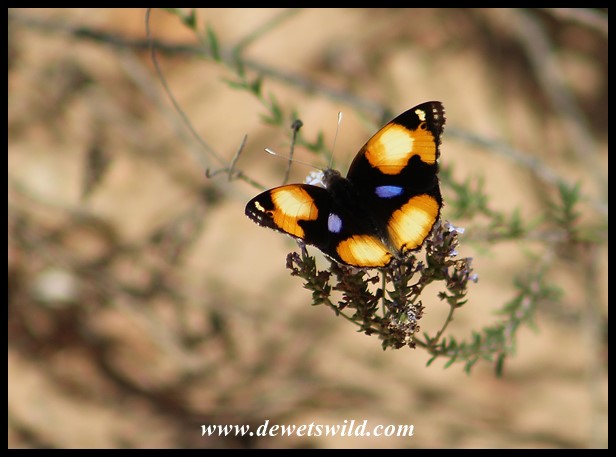Junonia hierta
The Yellow Pansy is a commonly seen butterfly occurring over most of South Africa. They are very active, flying low and fast and often returning to more or less the same spot – males may even be territorial. They occur in a wide range of open habitats and are usually seen singly.
The Yellow Pansy’s larvae feeds on a wide variety of herbs. Adults are on the wing throughout the year and measure 4-5cm from wingtip to wingtip. The IUCN lists the species as being of least concern. They occur widely over Africa, Arabia and the Indian subcontinent.
























You know Dries… I can’t recall ever seeing most of the butterflies you have shown lately!
Where was I? I recall the uproar about the Brenton Blue… bur I can’t remember chasing butterflies then, even though my love for nature has always been there!
Thanks again for all the trouble you are going to to sate my thirst!!
One day is one day… 🍻😁🦋
LikeLiked by 1 person
It really is as much a pleasure for me as it is for you, AJ. Such an interesting world! Perhaps the butterfly-population of the Eastern Cape is a bit different to here in the North of SA, so what’s commonly seen here may be rare there, and vice versa.
LikeLike
But of course it was necessary to see what a yellow pansy looks like – quite lovely! I’ve been photographing a lot of butterflies this year – they are very abundant — yet that is a bit alarming because the bird species census is very low… if the birds were here they’d be eating caterpillars – right?
I’ll keep watching and see if this is just a cycle, or if it’s something new….
Will catch up on your other posts soon – just not sure when… logging off til next week!
LikeLiked by 1 person
Always great to have you over for a visit, Lisa!
Great to hear that butterflies are doing well in your part of the world – did you notice the same trend with other kinds of insects as well?
LikeLike
The bees, unfortunately, are basically missing in action. the neighbor’s two hives are now ‘one’ – the other had one of those mystery disappearances of the bees two months ago….
|our planet is so fragile, it takes little to offset the balance, as you well know!
I’m noticing the cecroprias are pretty defoliated this year – I don’t remember seeing them that way in other years, but it might be normal.. or it might be that there are more caterpillars than there are birds to eat them! today the barbets were up there feasting in the cecropria crowns!
LikeLiked by 1 person
Fragile indeed, Lisa, and I think when it all comes crashing down it won’t be in slow-motion. It is going to be quick and catastrophic. When will our eyes open to the subtle signs around us?
LikeLike
Very pretty, and I think, quite well-named.
LikeLiked by 1 person
There’s no way this beauty goes unnoticed, so it must have a name that fits it perfectly!
LikeLike
Pragtige foto’s en dis darem ‘n mooie skoenlapper!
LikeLiked by 1 person
Dankie Dina! Nog een waarvan ons saam leer!
LikeLiked by 1 person
Ja, beslis!
LikeLiked by 1 person
So this is a yellow pansy! Well captured, i mean photographed…..
LikeLiked by 1 person
Thanks, Liz! Isn’t it just such an apt name for this delicate beauty?
LikeLike
Yes so true! I love the interchange in naming species – and pansies can float like that too 🙂
LikeLiked by 1 person
I love the color combination but I bet they can be hard to spot in many places.
janet
LikeLiked by 1 person
It’s only with the wings folded that they melt in with the background, Janet – these beauties certainly aren’t shy to show off!
LikeLiked by 1 person
Hats off to you again for capturing them on film – so many times too!
LikeLiked by 1 person
Thank you Anne – thankfully when they eventually land they sit dead-still for a second or two, allowing the camera to focus!
LikeLike
Such a delightful butterfly. Thanks for a cheerful post on an overcast wintery morning!
LikeLiked by 1 person
They sure can brighten a dreary day!
Sounds like pancake weather, Carol – When you start baking them have an extra one on my behalf… 😉
LikeLiked by 1 person
Good idea and will do 😊
LikeLiked by 1 person
Looks somewhat like a moth, but it is very pretty.
LikeLiked by 1 person
Sometimes the distinction between a moth and butterfly can be very indistinct, Beth – no reason why we can’t appreciate both I say!
LikeLiked by 1 person
beautiful
LikeLiked by 1 person
They certainly are – thanks for visiting!
LikeLike